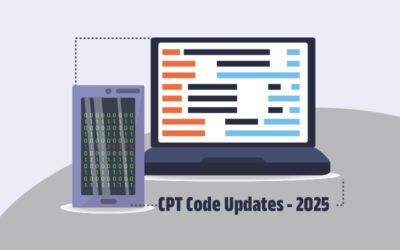Pain management involves a wide range of procedures, interventions, and medications, each requiring specific coding. Successful claim submission requires in-depth knowledge of medical terminology, CPT, ICD-10, and HCPCS coding guidelines, and payer-specific policies. Evolving state and federal regulations add to the complexity of pain management billing. Leveraging specialized pain management billing services is a practical way to manage your practice’s revenue cycle and optimize reimbursement.
This post looks into the commonly used codes in pain management, examines the recent code updates, and offers strategies to optimize revenue cycle management within this specialty.
Get expert support for pain management billing and coding!
Commonly Used Pain Management Codes
There are several CPT codes to communicate the specifics of pain management treatments and services. Medical codes commonly used by pain management specialists are:
- Epidural Steroid Injections
62321: Epidural injection, lumbar or sacral, with or without imaging guidance
62322: Epidural injection, cervical or thoracic, with or without imaging guidance
- Facet Joint Injections
64490: Injection, diagnostic or therapeutic, facet joint, cervical or thoracic
64491: Injection, diagnostic or therapeutic, facet joint, lumbar or sacral
- Radiofrequency Ablation
64633: Radiofrequency ablation, medial branch nerve(s), lumbar or sacral
64634: Radiofrequency ablation, medial branch nerve(s), cervical or thoracic
- Spinal Cord Stimulation
63685: Insertion of spinal neurostimulator electrodes, percutaneous
63688: Removal of spinal neurostimulator electrodes
- Trigger Point Injections
20552: Injection(s), single or multiple trigger point(s), 1 or 2 muscle(s)
20553: Injection(s), single or multiple trigger point(s), 3 or more muscles
- Spinal Procedures
62263: Aspiration, spinal fluid, lumbar
62264: Injection of a therapeutic substance into the lumbar or sacral space
Nerve Blocks
64450 Injection(s), anesthetic agent(s) and/or steroid; other peripheral nerve or branch
64486 Transversus abdominis plane (TAP) block (abdominal plane block, rectus sheath block) unilateral; by injection(s) (includes imaging guidance, when performed)
ICD 10 codes in pain management include:
- Chronic Pain
G89.21: Chronic pain due to trauma
G89.29: Other chronic pain
- Acute Pain
G89.11: Acute pain due to trauma
G89.18: Other acute pain
- Pain Management Diagnosis
M54.5: Low back pain
M54.4: Lumbago
2024 Coding Updates
The American Medical Association (AMA) announced a new Category I code on October 17, 2023, and it became effective on January 1, 2024. This new code is for arthrodesis, a minimally invasive procedure to place a stabilization device into the sacroiliac joint.
CPT 27278: Arthrodesis, sacroiliac joint, percutaneous, with image guidance, including placement of intra-articular implant(s) (e.g. bone allograft[s], synthetic device[s]), without placement of transfixing device.
The code was previously Category III code 0775T, but was converted to Category I, which means it is for procedures with a high level of clinical evidence and widespread use.
Strategies to Optimize Pain Management Billing
Know coding and billing rules: Understanding pain management billing and coding rules is crucial for ensuring accurate reimbursement, compliance, and effective patient care. Proper coding helps healthcare providers document and justify the complexity and necessity of pain management treatments, which in turn affects reimbursement rates and reduces the risk of claim denials or audits. Accurate coding also supports optimal patient care by ensuring that all treatments are properly recorded and tracked, leading to better outcomes and continuity of care. Moreover, adherence to these rules helps maintain compliance with legal and regulatory standards, safeguarding against potential financial and legal consequences.
In addition to staying up-to-date with the latest CPT and ICD-10 codes, optimizing pain management billing requires the following:
Proper documentation: Efficient billing requires thorough, detailed documentation. Medicare guidelines mandate that billing can only be performed for procedures that are explicitly detailed in the medical report. The patient’s medical record must contain documentation that fully supports the medical necessity for services. Include anesthesia records, the operation/procedure report (stating laterality), H & P reports, documents supporting diagnosis codes for the service/item billed such as results of pertinent diagnostic tests or procedures, documentation to support CPT code and modifier billed, documentation to support National Coverage Determination (NCD), Local Coverage Determination (LCD), etc. Comprehensive documentation is necessary to ensure complete and accurate coding. Proficient medical coders can interpret the clinical notes and adhere to the latest coding standards and guidelines.
Adherence to Medicare and private payer guidelines: When submitting medical claims, practices need to get the codes right and also comply with payer rules. One billing error that practices can make is applying the same rules across federal and commercial payers. Private payers may have different rules from Medicare for globals, bundling, coverage, and modifier usage and following these rules is essential for accurate billing. Private payer websites typically provide detailed payment policies and provider manuals that outline their specific coding and documentation requirements. The coding requirements for Medicare services are available on the Centers for Medicare & Medicaid Services (CMS) website. Providers can find relevant information in the Medicare Claims Processing Manual, as well as through Local Coverage Determinations (LCDs) and National Coverage Determinations (NCDs) published by CMS.
One example where payer rules differ is acupuncture. Medicare covers acupuncture but only for chronic low back pain. CMS defines chronic low back pain as that which:
- Lasts 12 weeks or longer;
- Is nonspecific, in that it has no identifiable systemic cause (i.e., not associated with metastatic, inflammatory, infectious, etc. disease);
- Is not associated with surgery; and
- Is not associated with pregnancy.
When billing acupuncture for chronic low back pain, check payer rules individually, or check the physician payer contract to see if they cover acupuncture for chronic low back pain.
An AAPC article recommends obtaining a signed Advance Beneficiary Notice of Noncoverage (ABN) from Medicare patients scheduled for acupuncture for their chronic back pain. Appending modifier GA Waiver of liability statement issued as required by payer policy, individual case to the acupuncture code(s), as appropriate will indicate an ABN has been obtained.
Know fluoroscopy billing rules: Fluoroscopy is a part of many radiological supervision and interpretation procedures, including, but not limited to most spinal, endoscopic, and injection procedures and should not be reported separately. However, there are separate fluoroscopic guidance codes (77002 for non-spinal) which may be reported separately for peripheral joints/ligaments/bursa (hips, shoulders, iliolumbar ligament, troch bursa, etc. (thepainsource.com).
Ensure correct modifier use: When reporting services/procedures, providers must use the correct modifiers. Here are some examples of modifies use for Medicare:
- Modifier 50 Bilateral Procedure indicates that bilateral procedures were performed in the same session. Before applying this modifier, the coder should check the CPT code definition to confirm that bilateral is not included in its descriptor. When injecting a sacroiliac joint bilaterally, apply modifier 50.
- Modifier 59 Distinct Procedural Service identifies procedures or services that are not usually reported together. This modifier indicates that a procedure is separate and distinct from another procedure on the same date of service. Modifier 59 may be applied to indicate the following: Different session or encounter on the same date of service; Different procedure distinct from the first procedure; Different anatomic site, and separate incision, excision, injury or body part. Report injection of separate sites (tendon sheath, ligament or ganglion cyst) during the same encounter on a separate line of coding and append modifier 59.
- LT – left side and RT – right side. When injecting a sacroiliac joint unilaterally, use modifier -LT or – RT as appropriate.
Appropriate modifier application depends on the particulars of the claim and the payer’s preference. An article from the California Medical Association notes that, “For Medicare and many commercial payors, proper application of modifier 50 increases reimbursement to 150 percent of the allowable fee schedule payment for the code to which the modifier is appended.”
Ensure Insurance verification and preauthorization: Verifying the patient’s insurance coverage and benefits is crucial to avoid denials and receive payment for services. Efficient insurance verification services will check patient insurance eligibility prior to the office visit to confirm the patient’s coverage status, services covered and deductibles. Physicians must also obtain advance approval from a health plan before a specific pain management service is delivered to the patient to qualify for payment coverage. For instance, pain medications and interventional pain procedures require prior authorization. The process of obtaining necessary approvals for pain management treatments can be a significant administrative burden for both pain medicine physicians and their patients. However, this process can be significantly streamlined and optimized with the right support and resources
Ensure that limits on approved procedures are not exceeded: If the number of procedures performed exceeds the limit prescribed, the visit(s) may be disallowed. AAPC references Mary I. Falbo, MBA, CPC, CEO of Millennium Healthcare Consulting, Inc. in Lansdale, Pa as saying,” Medicare patients will be limited to no more than 20 acupuncture sessions a year. Treatment must be stopped if the patient shows signs that they are not improving or are regressing.”
Optimize Your Pain Management Billing with Outsourcing
Outsourcing can help simplify and optimize the complex pain management billing workflows for your practice. Partnering with an experienced pain management billing company can ensure more accurate coding and improve your overall revenue cycle management.
These companies stay abreast of evolving regulations and maintain strong relationships with various payers, facilitating smoother reimbursement processes. Outsourcing your billing also takes the workload off your practice’s internal team, allowing them to focus more on providing excellent patient care.
Boost revenue and compliance with our medical billing and coding services!




